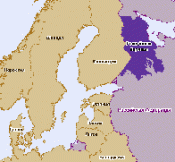
Karelian Labor Commune was established
June 8, 1920, there was established the Karelian Labor Commune (KLC) - national autonomy within the RSFSR.
History of the creation of the KLC is rooted in the events of the February revolution of 1917. In April 1917, the Union of Belomorsk Karelians asked the Provisional Government to authorize Karelia to self-government within the Russian Federation. In July, they elaborated a draft constitution of the future autonomy. It stipulated for the inclusion of the districts of Olonets, Povenets, Ukhta, Kem and Petrozavodsk regions. At first, the Soviet government was in no hurry to solve the "Karelian issue". Having recognized the independence of Finland, it welcomed the launch of the revolution in Finland in early 1918and even ceded the territory of Petsamo (Pechenga) to the revolutionary government.
However, the "Red Finns" failed, and in the spring of 1918, the White Finns launched the offensive, capturing a part of the Karelian districts. A year later, in the village of Ukhta (at present the village of Kalevala) there was organized the so-called government of the Arkhangelsk Karelia (Toymikunta). When the Civil War ended in the spring of 1920, it convoked a Congress delegates from nine districts of the Kem region townships, and in April, in Rayaёki (Finland) representatives of the Ukhta republic handed over to the Soviet delegation the resolutions of the Congress requesting to recognize the independence of the Republic of Karelia. These requirements were not supported by the Karelian districts of the Olonets, Petrozavodsk and Povenets regions.
Having discussed the principles of the national state system of Karelia, the Government of the Russian Federation in May 1920 met in the Kremlin with the former members of the Revolutionary Government of Finland. E. A. Gylling and Y. K. Sirola offered V. I. Lenin a plan for the construction of the Karelian statehood. According to their proposals, the autonomy within Russia not only could alleviate national problems, but could in the future serve as a model for the socialist transformation of the countries of Scandinavia. This idea was approved by the Political Bureau of the Central Committee of the RCP (b) and by the representatives of the 24 regions of the Olonets and Arkhangelsk provinces.
Karelrevkom – Karelian revolutionary committee including V. M. Coodgiev, V. T. Guriev, I. A. Nikitin, F. E. Pottoev, G. H. Bogdanov, I. A. Danilov, E. A. Gylling, J. T. Mäki, elected shortly after that, started to lead the Karelian Labor Commune (KLC). It included 43 districts within 3 regions with a population of 147,300 people (about 60% of the Karelians and 38% of Russians). The city of Kem was regarded to be the administrative center of the KLC, but finally the city of Petrozavodsk was chosen. Russian and Finnish languages were recognized as official and equal, the Commune was provided with special budget rights.
However, in 1921 the activists of the movement for separation of the north Karelian districts from the RSFSR attempted to achieve their goals by force. Supported by the Finnish volunteers, in November 1921 they seized power in Ukhta, where with the help of the Congress of "the representatives of the Karelian people," declared the independence of northern Karelia. The Soviet government in the early 1922 sent the Red Army to suppress the uprising. The result of the defeat of the government of Ukhta was the flight to Finland of about 11, 000 inhabitants (one year later more than 7, 000 of them returned).
In 1922, the Olonets province was abolished, and 13 more districts (Povenets and Pudozh regions) joined the KLC. In 1923, 5 districts of the Onega region (Arkhangelsk Province) joined the commune.
June 25, 1923 the All-Russian Central Executive Committee and the Council of People's Commissars of the RSFSR resolved to transform the Karelian Labor Commune into the Karelian Autonomous Soviet Socialist Republic (AKSSR).
Lit.: Бутвило А. И. История государственного управления в Карелии: учеб. пособие/ Петрозаводск, 2005. Из содерж.: Гл. 2, п. 2: Карельская Трудовая Коммуна, 1920–1923 гг. С. 76–86; Бутвило А. И. Новейшая история государственного управления в Карелии, 1917–2007 гг. : учеб. Пособие. Петрозаводск, 2008. Из содерж.: Гл. 3: Государственный аппарат Карельской Трудовой Коммуны в 1920-1923 гг. С. 25-39; Десять лет Советской Карелии, 1920–1930 : [сб. ст.] / ЦИК АКССР. Петрозаводск, 1930. Из содерж.: Декрет Всероссийского Центрального Исполнительного Комитета Советов об образовании Карельской Трудовой Коммуны [от 7 июня 1920 г.]. С. 8-9; Декрет Всероссийского Центрального Исполнительного Комитета и Совета Народных Комиссаров РСФСР об организации Карельской Трудовой Коммуны [от 4 авг. 1920 г.]. С. 13-14; Из протокола Всекарельского съезда представителей трудящихся карел – об образовании Карельской Трудовой Коммуны, [2 июля 1920 г.] // Петрозаводск: 300 лет истории : док. и материалы. Кн. 3. 1903-2003. Петрозаводск, 2003. С. 166-167; Карельская Трудовая Коммуна : (к 80-летию со дня образования) // Календарь памятных дат Карелии, 2000 год. Петрозаводск, 1999. С. 53–57; Килин Ю. М. Карелия в политике Советского государства, 1920–1941.Петрозаводск, 1999. Из содерж.: Гл. 1. 3 : Карельская Трудовая Коммуна. С. 39–55; Churchill, S. Itä-Karjalan kohtalo, 1917–1922 : Itä-Karjalan itsehallintokysymys Suomen ja Neuvosto-Venäjän välisissä suhteissa, 1917–1922 / Stacy Churchill. Porvoo; Helsinki, 1970. Sisäl.: Karjalan työkansan kommuunin luominen. S. 173–182; Neuvosto-autonomian vakauttaminen Itä-Karjalassa. S. 183–200; Karjalan Työkansan Kommuuni // Neuvosto-Karjalan vaiheista. Leningrad, 1933. S. 25-46.
Based on the Presidential Library’s materials:
Labor Commune (Autonomous Oblast) of Volga Germans was founded // On this day. 19 Oktober 1918;
Estland Labor Commune was established // On this day. 29 November 1918;
The material was provided by the National Library of the Republic of Karelia,
the article was written by journalist N. Kut’kov

